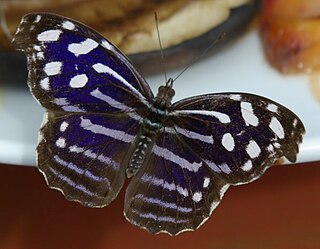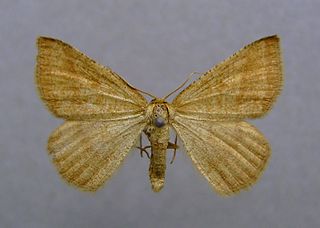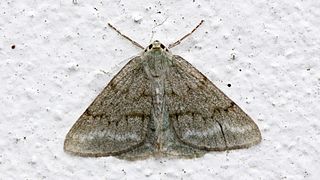
Pyraustinae is a large subfamily of the lepidopteran family Crambidae, the crambid snout moths. It currently includes about 1,280 species Most of them tropical but some found in temperate regions including both North America and Europe.

The Satyrini is one of the tribes of the subfamily Satyrinae. It includes about 2200 species and is therefore the largest tribe in the subfamily which comprises 2500 species.

Biblidinae is a subfamily of nymphalid butterflies that includes the tropical brushfoots. This subfamily was sometimes merged within the Limenitidinae, but they are now recognized as quite distinct lineages. In older literature, this subfamily is sometimes called Eurytelinae.

Acontiinae is a subfamily of bird dropping moths in the family Noctuidae. There are more than 50 genera and 430 described species in Acontiinae, found worldwide in temperate and tropical climates.

The Angeronini are a small tribe of geometer moths in the subfamily Ennominae. The tribe was first described by William Trowbridge Merrifield Forbes in 1948. As numerous ennomine genera have not yet been assigned to a tribe, the genus list is preliminary.

The Eudaminae are a subfamily of skipper butterflies. Their original type genus Eudamus is today a junior synonym of Urbanus. They are largely found in the Neotropics, with some extending into temperate North America, and one genus, Lobocla, endemic to East Asia.

Aedia is a genus of noctuid moths erected by Jacob Hübner in 1823. If it is placed in Catocalinae, it is assigned to its own subtribe, Aediina and if placed in Acontiinae, it is assigned to its own tribe Aediini.

Though small in absolute diversity of genera, the Hemitheini are nonetheless the largest tribes of geometer moths in the subfamily Geometrinae. Like most Geometrinae, they are small greenish "emerald moths". The tribe was first described by Charles Théophile Bruand d'Uzelle in 1846.

Aplasta is a monotypic moth genus in the family Geometridae erected by Jacob Hübner in 1823. Its only species, Aplasta ononaria, the rest harrow, was first described by Johann Kaspar Füssli in 1783. It is found in southern Europe to Anatolia and from England to the Baltic states.

Euchoeca is a monotypic moth genus in the family Geometridae erected by Jacob Hübner in 1823. Its only species, Euchoeca nebulata, the dingy shell, was described by Giovanni Antonio Scopoli in 1763. It is found in the Palearctic realm, from Europe across Russia to Japan.
Eudule is a genus of moths in the family Geometridae erected by Jacob Hübner in 1823.

Therapis is a monotypic moth genus in the family Geometridae first described by Jacob Hübner in 1823. Its only species, Therapis flavicaria, was first described by Michael Denis and Ignaz Schiffermüller in 1775. It is found in south-eastern and eastern Europe, east to Turkey, Russia and Georgia.

Coeini is a tribe of brush-footed butterflies. Its members are found in the Neotropical realm.

Euparthenos is a monotypic moth genus in the family Erebidae erected by Augustus Radcliffe Grote in 1876. Its only species, Euparthenos nubilis, the locust underwing, was first described by Jacob Hübner in 1823. The adults resemble some of the underwing moths of genus Catocala, which are fairly close relatives, in color, pattern, and the habit of resting on tree trunks. But E. nubilis can usually be immediately recognized by the four concentric black bands per hindwing, as opposed to one or two in Catocala. Color morphs of E. nubilis with altered pattern are known, however, and these may be hard to recognize without detailed examination.

Asthenini is a tribe of geometer moths under subfamily Larentiinae first described by Warren in 1893. The tribe has been combined with Eupitheciini in the past, most notably by Jeremy Daniel Holloway in his work The Moths of Borneo.

The Pseudoterpnini are a tribe of geometer moths in the subfamily Geometrinae. The tribe was described by Warren in 1893. It was alternatively treated as subtribe Pseudoterpniti by Jeremy Daniel Holloway in 1996.

Glaphyriinae is a subfamily of the lepidopteran family Crambidae. It was described by William Trowbridge Merrifield Forbes in 1923. The subfamily currently comprises 509 species in 75 genera.

Baptini is a tribe of geometer moths in the subfamily Ennominae.

Margaroniini is a tribe of the species-rich subfamily Spilomelinae in the pyraloid moth family Crambidae. The tribe was erected by Charles Swinhoe and Everard Charles Cotes in 1889, originally as family Margaronidae.

Nomophilini is a tribe of the species-rich subfamily Spilomelinae in the pyraloid moth family Crambidae. The tribe was erected by Vladimir Ivanovitsch Kuznetzov and Alexandr A. Stekolnikov in 1979.



















